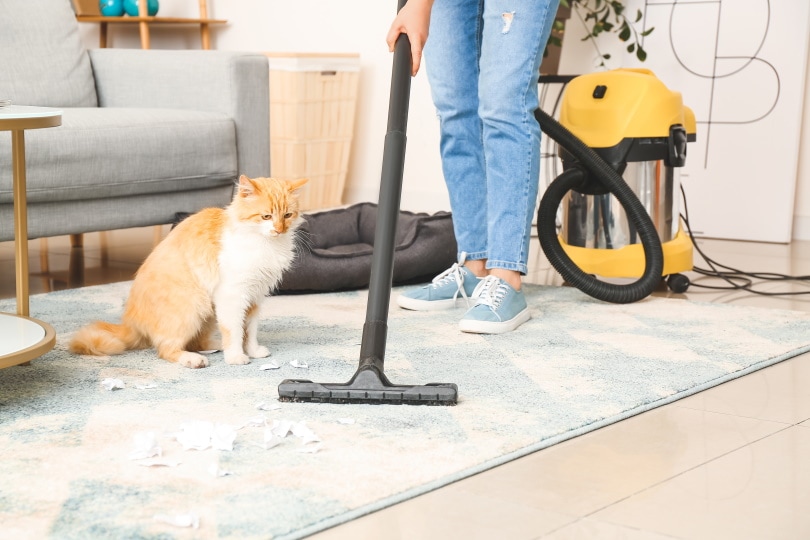
If you’ve noticed your cat excessively scratching or biting themselves, moving around with irritation, and spotted little black creatures running around their skin—you’ve got a flea problem. Chances are that if you look along your own body, you’ll find little red bumps along your own skin too.
Unfortunately, simply washing your cat with shampoo to kill the fleas isn’t going to make much of a difference. You may kill the fleas that are currently on your cat, but once your cat is dry and back in their cat bed, they’ll be covered in fleas once again. The truth is that if you can see adult fleas on your cat, there will also be eggs, larvae, cocoons, and other adult fleas in your cat’s bed and on your carpets, sofas, blankets, etc.
Fleas produce eggs in large quantities, laying up to 50 a day and around 2,000 in their potentially 100-day lifespan. Due to this rapid rate, it’s essential to act quickly once you notice that little black flea for the first time. The longer you’ve had a flea problem, the longer it’ll take to rid your home of them.
Before You Start
Before cleaning your home to rid it of fleas, start by treating your pets. They’re the ones walking around, carrying the fleas with them. They’re also the ones that are having the greatest difficulty with the fleas because those pesky little creatures are living in their fur, sucking their blood and causing them to frustratingly scratch themselves to ease the itch.
To rule out any other itchy possibilities your cat may be experiencing, take a flea comb and brush it through your cat’s coat. The fine bristles will separate your cat’s hair and expose the fleas. When you start brushing, you’ll most likely notice dark flakes fall onto the surface your cat is sitting on. Wet some cotton or a white cloth and gently press against the flake. If it turns red, it’s defecation from fleas, and you can rule out any other possibilities.
Flea Treatments for Your Cat
There are different treatments available to kill the fleas on your cat.
1. Topical Treatment
You can purchase these topical treatments from your vet, online, or pet care stores. Do not allow for any guesswork, and read the instructions because they’ll differ depending on your cat’s age, type, and weight. This medication will work within hours but may take a few days before it has killed all the fleas and eggs nestled in your cat’s coat.
The great thing about topical treatment is that you apply it to the back of your cat’s neck, and it’s effective for a full month. It will work throughout your cat’s skin and kill fleas on contact without them having to bite first. You can use this product indefinitely to protect your cat from future flea bites.
2. Oral Treatment
Another effective flea treatment is in the form of tablets. However, this product is absorbed into the bloodstream, so fleas will only die when they bite your cat. It kills the fleas, but it also leaves your cat vulnerable to bites and discomfort.
3. Flea Collars
A convenient flea treatment is in the form of a collar—and you won’t have to worry about fleas on your cat for up to 8 months! The active ingredients protect your cat’s whole body and kill fleas on contact without any biting necessary.
4. Flea Powders
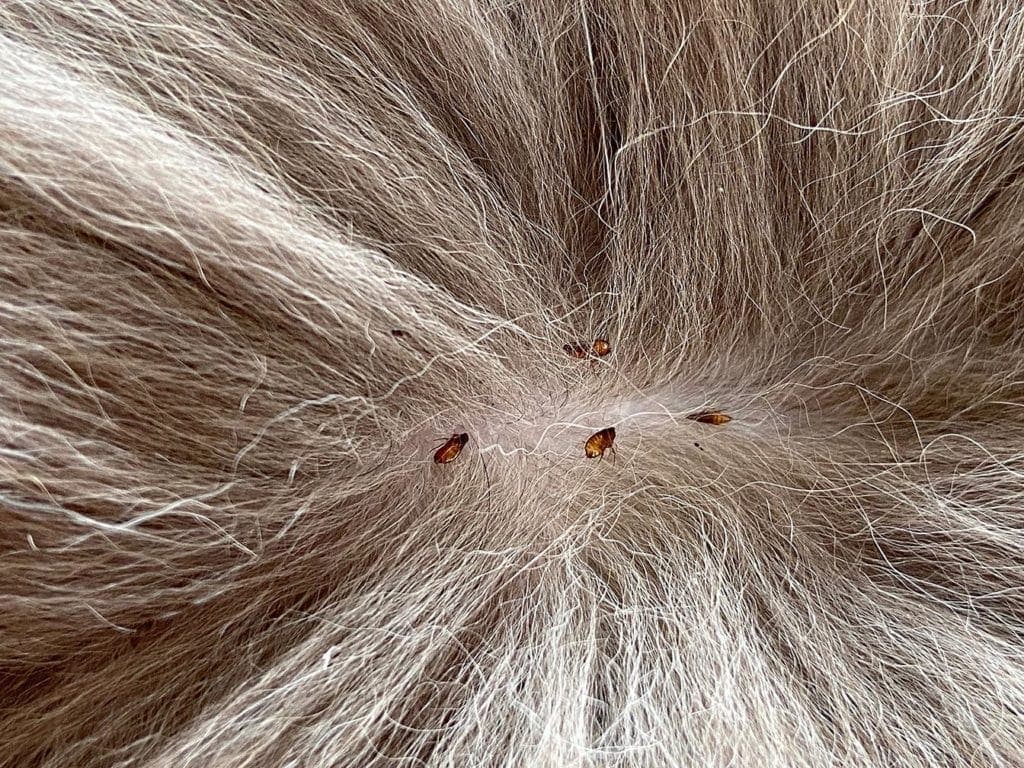
The least effective treatment is flea powder. It may kill the fleas when it’s rubbed into the coat, but once the powder has been rolled, shaken, or patted off, it no longer protects your cat.
5. Anti-Flea Bath
Another option is an anti-flea bath. You’ll need to purchase cat-friendly flea and tick shampoo as normal cat shampoo may not be effective enough. The trouble with flea baths is that they’re not a long-term solution, and your cat may find the process distressing because they typically don’t like water and will fight you to get out of it. Instead of dealing with an upset cat and scratches along your arms, get them topical or oral treatment or a flea collar.
How to Rid Your House of Fleas
Now that you’ve got your cat’s personal flea problem under control, it’s time to tackle your home. You may need to frequent these steps a few times over the next month to get the best results. There are several steps you’ll need to take thoroughly clean your house of fleas, so let’s get into it:
1. Clean Your Cat’s Bedding
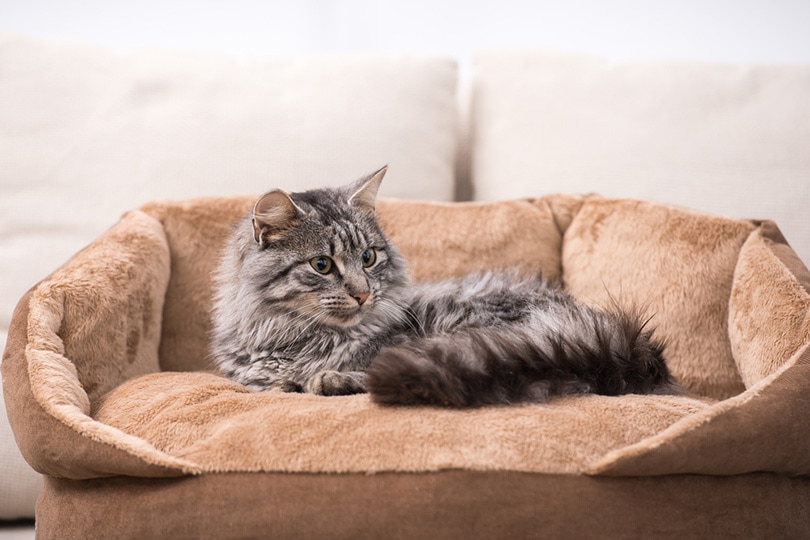
Fleas die under high temperatures, so putting your cat’s bedding in the washer at the highest temperature the material allows will kill any fleas or eggs hidden within it. Do the same with the tumble-dry cycle too. Once it’s dried, make sure to vacuum their bedding on a daily basis until your house is flea-free.
2. Wash Your Own Bedding
You may think that fleas only lurk around your cat’s belongings, but that’s not true. Fleas thrive in warm, shaded, and undisturbed areas—making your bed and cushions the perfect spots.
Just as you washed and tumble-dried your cat’s bedding under high temperatures, do the same for your blankets and cushion covers on both your bed and sofas.
3. Vacuum Everything
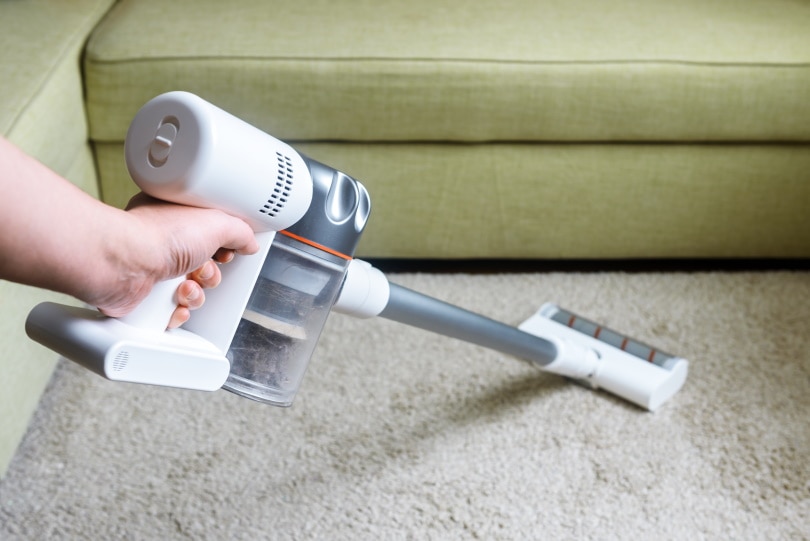
An important step that cannot be skipped is vacuuming your whole house—and often. Fleas love to hide in cracks, on your sofa, on the carpet, on your mattress, and in other nooks and crannies.
Use a powerful vacuum over each of those spots, and don’t rush the process as you want to suck up as many fleas or eggs as possible that may be in your path.
For the best and fastest results, vacuum at least once a day. Make sure to tie the top of the vacuum bag securely and throw it away.
4. Use a Steam Cleaner
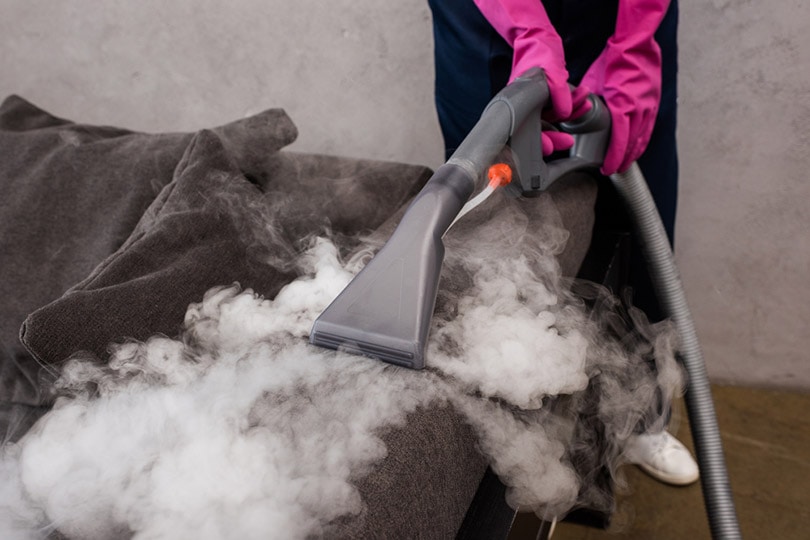
As we’ve mentioned, fleas hate the heat, and this is why using a steamer is such a great idea. Make sure to use a steam cleaner that requires detergent so that the fleas will have no chance of survival.
5. Add Catnip Plants to Your House
Adding plants to your home has many wonderful effects, such as boosting your mood, cleaning the air, and producing oxygen. Some smelly plants also repel fleas. If you have some rosemary or sage plants in your yard, place some potted plants around your house. Even your cat’s favorite, catnip, is also a flea repellent! Please beware that many of the natural flea-repellent plants that we did not include here can be toxic to cats so double-check before bringing potted plants inside your home.
Don’t Forget Your Yard

Fleas may not only be a problem in your home but also in your yard. It’s important to put as much effort into your yard as you put into your home, especially if your cat goes outside to play.
- Mow your lawn. Fleas hide in the long grass your cat enjoys rolling in. To avoid both ticks and fleas, it’s necessary to keep your grass short.
- Rake. Once you’ve mowed the grass, be sure to rake it up, along with other leaves and debris that may be around. Rake it all into a bag and tie it securely.
- Use cedar chips. Scatter these around your yard, adding a fair amount around the areas your cat usually lays and plays. The smell of cedar chips repels fleas, and they won’t want to hang around for long. However, you will have to restrict your cat’s access to these areas as the phenols and terpenes of the cedar chips can be toxic to your cat too. Once you get the fleas under control, the routine can be re-established as usual.
Conclusion
Fleas are a huge nuisance that not only bothers you and your cat but can cause illness if ignored. In the process of ridding your house of fleas, start by putting your cat and other pets on flea treatment. There are various treatment methods, with some being more effective than others.
Once your cat has been taken care of, start your house cleaning. Make sure to wash your cat’s bedding, along with your own, at a high temperature in both the washer and tumble dryer. While the cycle is running, start vacuuming your house, taking extra notice of all the nooks and crannies. You can use a steam cleaner over all other surfaces.
Don’t forget about your yard—simply mowing, raking, and scattering cedar chips (with temporarily restricted access to your cat) will reduce the flea population outside. If the flea problem is too great for you to manage, call in the experts.
See Also:
Featured Image Credit: Pixel-Shot, Shutterstock











